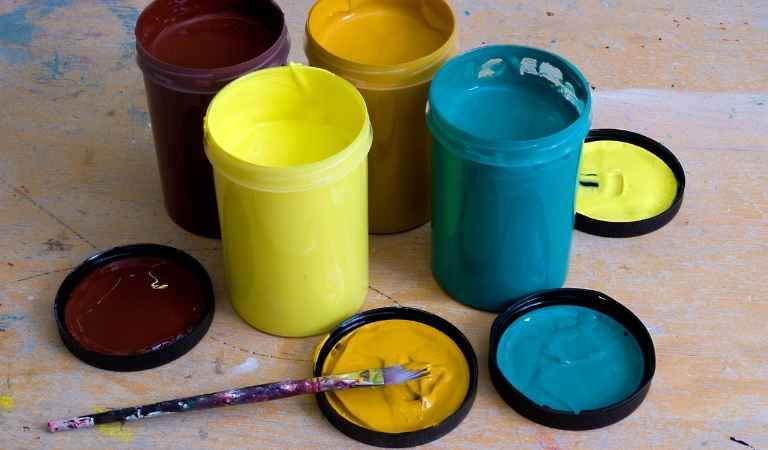Acrylic paint is a favorite among artists because it’s easy to use, affordable, and comes in a variety of colors.
Unfortunately, acrylic paint can be just as difficult to dispose of when the time comes.
These paints are made from different chemicals that react with each other in certain ways and produce toxic fumes unless you dispose of the leftover perfectly.
This article will show you how to properly dispose of these types of paints at home!

5 Effective Ways to Dispose of Acrylic Paint
There are many ways you can dispose of acrylic paint, we’ll go over them one by one and show you how can you do that efficiently depending on the amount of paint you have left-
- Only an inch at the bottom of the can is left
- Half of the can is left
- Fully sealed paint cans are left
- Disposing of the Brush and sponges cleaning solution
- Disposing of in the local hazardous water center for toxic paints
1. Ways to Dispose of a Little Amount of Acrylic Paint
If you have a little amount of leftover paint, you can dispose of them by letting the paint dry out. The paint should dry out and harden in about a week when you let air in the paint can. Then you can dispose of the dried paint by dumping it into the trash or throwing it away with regular household waste.
When disposing of, make sure to cover your hands with gloves and wear protective clothing like an old long sleeve shirt that you don’t mind getting stained since acrylic paints are messy and will get on your hands and clothes anyway.
Make sure to use an old container that is not being used, or a new one if possible since you don’t want to mix the leftover paint with other things already in there. Keep the lid closed as much as you can and put it into a bag or box so that no air gets in there.
2. Disposing of a Partially Full Paint Can
If you have a partially full can of paint, you have to be careful in your disposal method. The best option is to give the paint to a friend who can utilize it.
If you are not interested to go in that route, you need to use cat litter or sand to mix with the paint. Mix in a 1:1 ratio so that the paint and cat litter thickens to a hard consistency. Make sure to stir the paint and litter to mix them up perfectly. After doing that, pour the mix into a garbage bag and wait until it dries out.
The cat litter or sand will absorb any leftover liquid so that the paint does not spill. Once you’ve waited enough to dry out the leftover paint, throw it away with regular household waste.
3. Disposing of Sealed Cans of Acrylic Paint
The best way to get rid of sealed cans of paint is by donating them. You can send the paint can to any of your friends, neighbors, or anyone who may be in need of acrylic paints.
However, some paint shops may take back the sealed paints that they’ve sold earlier to you. If you bought from any of those shops, you can go back and ask them for a return. They will take the paint since it is not yet opened and there’s no need to test the paint brand.
If you are not interested in giving away the paints back or sending them to other people, then your option is to dispose of the sealed cans in the trash.
If you do dispose of them in the trash, make sure to place a liner underneath it so that no paint spills on other household garbage. Then wrap the can with plastic and tape the edges securely before placing it inside another garbage bag. This prevents chemicals from leaking when you throw them away.
Note: Don’t throw away paint that is labeled as ‘hazardous’.
4. Disposing of Brush and Sponge Cleaning Solutions
The cleaning solution that you used for getting rid of excess paint of the paintbrush and sponge also requires an extra step in its disposal. This is because the residue of the cleaning solution is toxic and causes irritation to one’s skin if it comes into contact with it.
For this to dispose of, take a bucket of sand or cat litter, you don’t need a full bucket rather only enough to absorb the liquid solution. Stir the cleaning solution so that there remains no solid paint at the bottom of it. Then, pour it slowly into the bucket of sand or cat litter.

When pouring, make sure to put your face away from the cleaning solution while it is being poured in since you don’t want any of its residues to be spoiled onto your nose and mouth. When finished pouring, cover the bucket with plastic so that no air gets inside. The sand will absorb the cleaning solution while preventing any toxic residue from leaking out.
Once it is all absorbed, dump the mixture into a trash bag and put it in your garbage can that is placed outside, making sure to cover the lid with plastic or a plastic bag. This helps avoid any smell of fumes before disposing of them in an open area.
5. Taking the Paint to the Local Hazardous Water Treatment Plant
Finally, you can also take the leftover paint to your community hazardous water treatment plant. This will ensure that the liquids are properly disposed of and do no harm to the environment.
You can find your local hazardous waste treatment facility by doing an online search using their name along with your zip code. If done correctly, they will not only take away the leftover paint liquids but will also dispose of them in a water treatment facility that is used specifically for disposing of hazardous wastes.
Given this, you have 5 methods to choose from when disposing of your acrylic paints. The best one to use depends on your preference and situation. However, with any method, make sure that you follow all the proper steps in order to prevent any form of contamination.
Frequently Asked Questions
Can you pour acrylic paint down the drain?
This depends on whether you’re using non-toxic or toxic paint. Water-based acrylic paints can be poured down the drain and easily cleaned with hot soapy water when the paint is not toxic. However, you need to dilute the paint to the consistency of water to eliminate any risk of clogging up the pipes.
If the paint can is labeled as ‘hazardous’ then you should go with Method #5 discussed above.
Is acrylic paint recyclable?
Yes, it is. Because acrylic paint is water-soluble, it can be recycled; however, to avoid contamination with other materials that are not recyclable such as food scraps and metal lids, it is best to place it in a special bin.
Plus, not all recycling centers take acrylic paints. So, you need to find the right recycling center for it.

How do I properly dispose of my old paintbrushes?
First, remove leftover paint by soaking the brush in mineral spirits or paint thinner for a while (or until you’re sure all of the bristles are clean). Now thoroughly clean and dry the brush with soap and water.
Then gently bend over bristles to reshape them, then set aside on paper towels to let them dry completely. Finally, store so that it’s away from children or pets. After that, you can send this to a recycling center or simply throw it away with household waste.
Is acrylic paint considered hazardous waste?
The resin in acrylic paints is considered non-hazardous waste, so you can dispose of it with your household trash.
However, some people say that fumes from the paint can be harmful. Is this true?
The fumes may not be toxic enough to harm you, but they could give you a headache. The best way to avoid the fumes is by using good ventilation and working in a well-ventilated area or outdoors. You should also use a respirator if you are working in an enclosed area or cannot get adequate ventilation.
However, some water-based paint comes with hazardous chemicals inside, but they’ll have a clear hazardous material sign on the product label.
How do you dispose of acrylic paint in water?
The best way to do this is to filter the paint through paper towels or rags.
Then let it dry and dispose of it in the trash. And the water content that you have filtered out can be easily disposed of in the water. Before disposing of in the water, make sure you dilute the paint perfectly so that it doesn’t harm your plumbing system.
What kind of paint can you throw away?
Acrylics are a biodegradable product and can be disposed of without any worries. But you need to check on with your city’s regulations just in case.
The main thing that helps paint degrade is sunlight and air. Do not put it into the trash immediately because other materials tend to stick onto it, which makes disposal via incineration very difficult.
You should allow at least 7 days for the paint to dry before putting it into the trash. This will also help you be sure that it has broken down to a safe condition and nothing harmful remains wet in the paint.
Can You Wash Acrylic Paint Brushes in the Sink?
No, you shouldn’t wash acrylic paint brushes in the sink because the solvent in the acrylic paints is hard to rinse out of the brush and will trap clog up the sink.
You need to wash the brush in a separate 1-gallon bucket with the cleaning solution and then you may dispose of that wastewater in the sink, only if the solution is non-toxic.
Don’t think that you can directly pour over the wastewater in the sink if it is non-toxic, but that may cause issues with plumbing pipes. Make sure to dilute the non-toxic wastewater before pouring it into the sink.
Can You Recycle Acrylic Paint Bottles?
Yes, you can recycle your empty acrylic paint bottles. Maybe you’re a painter and you have enough used up tubes, or maybe the kids devoured all your pastels again. Before tossing them in the trash, consider trying something new with those wastes.
Making things with waste is one of the most fun and fulfilling ways to recycle. A great example of a simple craft using waste is the beads we make from old glass bottles. These glass bottle beads turn into beautiful jewelry, and they are so easy to make!
